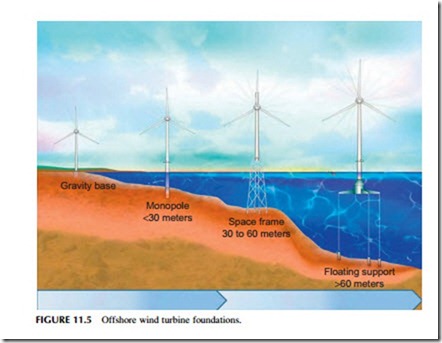OFFSHORE WIND TURBINE TECHNOLOGY
Offshore wind power started to accelerate toward the end of the first decade of the 21st century and has become an important part of global wind power expansion. By the end of 2012 global capacity had exceeded 5400 MW. Most of this capacity is in Europe but development in both Asia and the United States are anticipated. China has started to build offshore wind farms, as has South Korea, and Japan is exploring its use as a potential replacement for nuclear capacity.
Wind turbines for use offshore are similar to those used onshore, and offshore wind turbines lean heavily on the technology developed for onshore units. However, offshore turbines have to be more rugged than onshore turbines because of the harsher environment. Additionally, offshore wind turbines can be significantly larger than those used onshore. This is important because using larger units can partially outweigh the additional cost of creating a wind turbine foundation offshore. It is the latter that is primarily responsible for making offshore construction more expensive than onshore.
Offshore construction has several advantages over onshore construction. One of the most important is that there are fewer environmental restrictions so that it is often easier to gain permission for development offshore than for construction onshore. The wind regime is generally better offshore too and this means that similarly sized wind farms will generate more power, more reliably.
As a result, offshore wind development, where it is feasible, is likely to become increasingly important over the next 10–20 years.
Against these advantages, offshore development is more expensive than development onshore. As already noted, the most important additional expense is the construction of the foundation for an offshore wind turbine (Figure 11.5). Then, once the turbines have been installed, they are subject to much more severe conditions than onshore so reliability is a key issue. On top of that, off- shore maintenance is much more difficult to carry out and therefore also more costly than for a similar unit onshore. All these factors affect the economics of offshore construction.
There are a variety of structures that can be used to establish an offshore wind turbine foundation. The most common of these is a simple monopole tower, similar to the tower used onshore. The foundation for this type of struc- ture is created by using a pile driver to drive a steel monopole into the seabed. This base structure normally terminates with a flange at just above sea level and the tower to support the nacelle and rotor is bolted to this flange. Monopoles can be used in depths up to around 30 m, provided the seabed is suitable for pile driving, but beyond that depth the driving the base becomes more difficult. For long monopoles, resonance effects may also start to come into play and this will limit their applicability.
For shallow waters the main alternative to the monopole is the gravity base structure. This is a massive foundation, usually fabricated onshore from concrete sections then floated to the wind turbine site and then sunk to the seabed by loading it with ballast. The wind turbine is then attached to the concrete base that relies on its mass to remain stable. Gravity structures can be used for a variety of seabed conditions but site preparation is necessary to ensure the base sits horizontally. Otherwise, the result is a wind turbine that is not perpendicular.
For deeper waters a range of tripod and space frame foundations can be used. These will have three or more legs, each anchored to the seabed to provide a wide, stable base. The wind turbine is again bolted to the top of the foundation structure. Such structures are the most economical in water depths of 40–60 m.
Stabilizing an offshore wind turbine in water depths greater than 60 m becomes increasingly expensive, and at this depth the only real solution is some form of floating support. No major wind farms have yet been deployed with floating supports but a number of designs are being tested. These include fully buoyant platforms that are anchored in deep water and can support multiple wind turbines; single turbine supports including spar buoys that are partially submerged and anchored to the seabed; and tension leg platforms with several legs that are partially buoyant but are held in position under water by steel guys under tension.
Wind turbines for offshore use have to be more rugged than onshore units so that they can resist the corrosive effects of seawater. Maintenance is much more difficult to carry out offshore too because of the access problems. To improve offshore reliability wind turbine manufacturers are developing remote monitoring and control systems that can both identify and manage faults as they develop so that units can be kept in service and until maintenance can be carried out.
Another issue with offshore development is the means of bringing power ashore. Most of the early offshore wind farms in European waters use simple AC transmission lines to bring power from an offshore substation to a substation on shore. However, as the distance from shore increases, AC transmission becomes less effective because of capacitive losses and it is necessary to switch to high-voltage DC (HVDC) transmission. The crossover between the two systems, economically, is generally considered to be around 100 km. HVDC trans- mission lines are beginning to be introduced for offshore wind farms in European waters.
For agglomerations of far-from-shore wind farms there are also arguments for setting up dedicated offshore grids that can be linked to onshore grids at more than one point. Typical of such proposals is the North Sea Supergrid, which would link several littoral countries both to multiple offshore wind farms and to one another.
